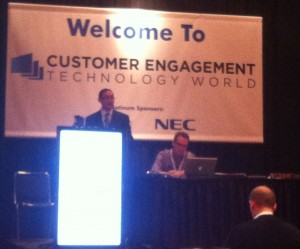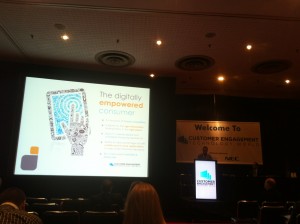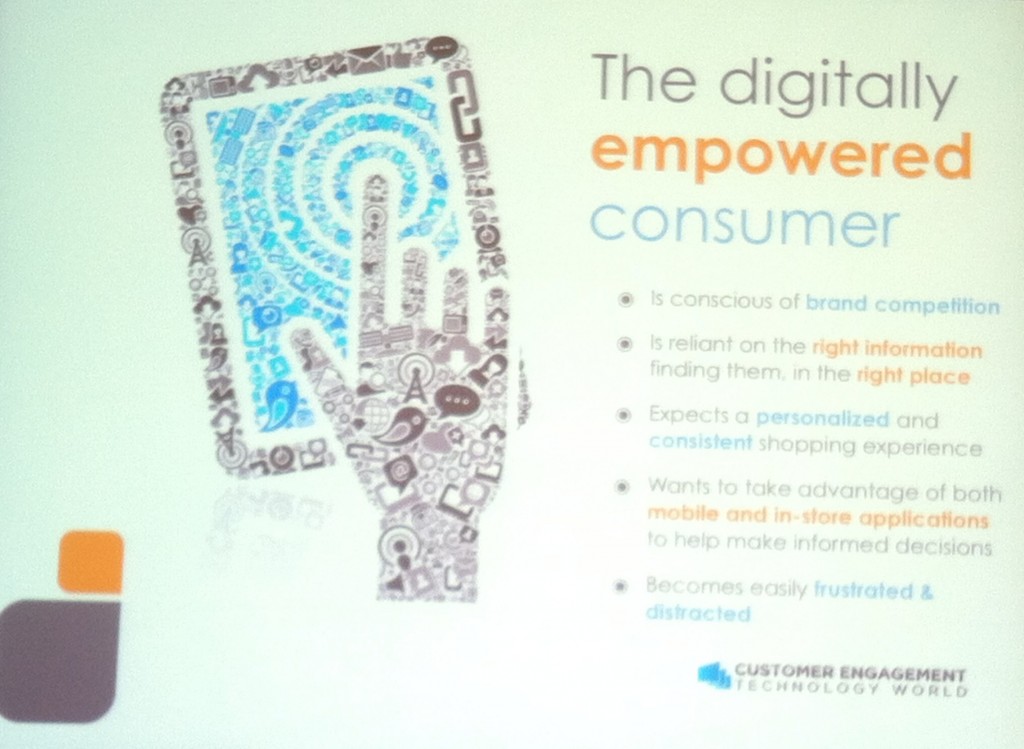Transforming DOOH At Retail
A panel titled ‘How To Carry DOOH Messaging Through the Retail Purchase Process‘ from last week’s #CETW focused on the best practices of how digital signage and emerging mobile technologies can enhance any brand experience at retail.
 During the presentation that featured panelists Bryan Meszaros of Open Eye Global and Andy Austin of EWI Worldwide, attendees learned how to effectively leverage digital signage with the brand’s sales messages in the retail environment.
During the presentation that featured panelists Bryan Meszaros of Open Eye Global and Andy Austin of EWI Worldwide, attendees learned how to effectively leverage digital signage with the brand’s sales messages in the retail environment.
Surprising statistics shared throughout were that 31% of consumers feel that digital signage can enhance their shopping experience while at least 50% of consumers feel that digital signage significantly impacts their shopping experience.
A retail paradigm that encompasses a cycle which includes key factors like Price & Value, Store Environments, Consumer Experience, Customer Engagement and Merchandise Authority was shared by Mr. Austin to show how a brand can increase their effectiveness when deploying in-store digital signage.
This strategy dictates that brands should select two dimensions of the cycle to focus on to align the brand experience with the overall brand strategy while achieving parity on the remaining dimensions.
To show how technology can increase consumer loyalty, Mr. Austin shared great case studies like the Fisker Automotive App Experience, the AT&T Experience Store and AT&T 4G Experience Lab, which exemplified how to achieve a seamless execution between the Shopper, the Salesperson and the Retail Environment.
 For technology to drive loyalty in brand retail spaces, Mr. Meszaros shared that technology must be combined with the brand’s overall strategy and the brand’s retail environments.
For technology to drive loyalty in brand retail spaces, Mr. Meszaros shared that technology must be combined with the brand’s overall strategy and the brand’s retail environments.
In today’s marketplace where the new retail currency is the consumer experience Mr. Meszaros highlighted a concept called the Zero Moment of Truth.
At the center of this new path to purchase and increased conversions, called the Zero Moment of Truth that included several key factors like the Stimulus, the Social Interaction, the Retail Shelf and the Consumer Experience is the Digital Experience.
This Digital Experience connects consumers path to purchase, prevents disruptions in the conversation, reinforces brand information by delivering the same brand message seamlessly across digital signage, mobile devices and in-store retail kiosks.
Attract.
The Hollister Digital Store fronts are great a case study of how a brand can use digital signage technology in a totally radical way to attract consumers.
Engage.
The HMV Augmented Reality Experiences shows how a second screen in the store or a mobile device can effectively engage consumers once they are in the retail environment.
Influence.
The TopShop Virtual Fitting Room that allows shoppers to use virtual reality technology to see themselves in a mirror wearing a particular item is an innovative and unique way of how to influence a consumer during the purchase process.
Conversion.
The Urban Outfitters iPad Checkout system was a nice example of how in-store digital kiosks can be used within the shopping experience to convert the digital experience in to sales.
Let’s hope more brands can leverage these insights and strategies to effectively utilize digital-out-of-home and mobile devices to better engage consumers in the retail environments to enhance the customer experience.


Follow DailyDOOH